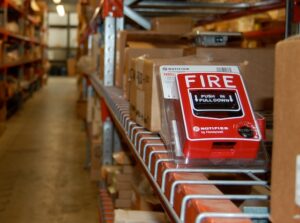
Fire alarm pull stations are very reliable, but understanding how they work is important.
Every commercial building needs a working fire alarm system to comply with fire codes. As such, there will manual fire alarm pull stations in every building you visit. Fire alarm pull stations have not changed a whole lot over the years. However, they are often overlooked, as most buildings have automatic smoke or heat detectors. Automatic fire alarm systems are reliable and a great defense against fire, but understanding how manual pull stations work is important knowledge to have. Read on to learn all about them!
What Really is Fire Alarm Pull Station?
A fire alarm pull station is a manually activated component of your fire alarm system. Typically, a red box mounted on a wall, the stations are clearly labeled with instructions on how to operate correctly. Although meant to accomplish the same thing, there are two different types of fire alarm pull stations. They are:
- Single Action Pull Stations – Single-action pull stations are very simple in their design. They are fitted in a wall without any coverings or specialized activation mechanisms. These pull stations are activated by just pulling the handle down.
- Dual Action Pull Stations – Dual-action pull stations are activated through an easy two-step process. They are like a single-action pull station, except they’ve got safeguards in place designed to discourage any mischief or accidental activation. These pull stations feature a two-step activation sequence, like lifting a cover over your handle before pulling it all the way down to activate the fire alarm. In some cases, these pull stations might include a break glass or plexiglass cover requiring breakage or additional action to access the device.
Requirements for a Fire Alarm Pull Station
Fire alarm pull stations seem commonplace. They are required for buildings to comply with fire codes and regulations, including buildings with automatic fire detection and alarm systems. They are considered a failsafe if smoke or heat detectors fail to sense smoke or heat before humans do. They also protect against system malfunction. The number of pull stations required for a building depends on the size and occupancy classification. Manual pull stations should be no more than 200 feet from any normally occupied room and within 60 inches from each exit. Manual pull stations must be inspected and operationally tested annually as part of the overall fire alarm system inspection and test. A professionally licensed fire protection firm must be used to perform this task.
Fire Protection Services from Fireline
Whether you need smoke detectors, fire extinguishers, or an automatic sprinkler system installed at your commercial property, Fireline has you covered. We have been protecting people and property from fire damage since 1947—and this experience shows in our excellent work! We are known for our superb customer service, fire protection expertise, and reliability. For more information on how we can help your residential or commercial property, visit us online or give us a call at (800) 553-3405. We are located in Baltimore, MD, with a second office in Leesburg, VA. For more fire safety tips, be sure to follow us on Facebook, Twitter, and LinkedIn.
